Having indoor plants for office can greatly enhance the workspace, improving both the aesthetic appeal and the overall well-being of employees. Studies have shown that office plants not only purify the air but also boost productivity and morale.
By incorporating the right office plants into your work environment, you can create a more welcoming and healthy space. This guide will explore the best plants for office spaces, providing you with the knowledge to choose the perfect greenery for your workplace.
Key Takeaways
- Office plants improve air quality and boost productivity.
- The right plants can enhance the aesthetic appeal of your workspace.
- Certain plants are better suited for office environments.
- Having plants in the office can improve employee morale.
- A well-chosen plant can thrive in a variety of office conditions.
Why Plants Belong in Your Workplace
The inclusion of plants in workplace design is backed by science, showing numerous benefits for office environments. By understanding the advantages of having plants in the workplace, businesses can create a more productive and healthier space for their employees.
The Science Behind Plant Benefits
Studies have shown that plants can reduce stress and improve mood, contributing to a more productive work environment. The presence of plants has been linked to lower blood pressure, reduced anxiety, and improved cognitive function. This is because plants help purify the air and create a more natural ambiance, which can be lacking in traditional office settings.
| Benefits | Description |
|---|---|
| Air Quality Improvement | Plants absorb pollutants and release oxygen, enhancing indoor air quality. |
| Stress Reduction | The calming presence of plants can reduce employee stress levels. |
| Productivity Boost | A healthier environment contributes to improved focus and productivity. |
How Plants Transform Office Environments
Plants not only improve the aesthetic appeal of an office but also play a significant role in transforming the work environment. By incorporating plants, offices can become more inviting and comfortable, fostering a sense of community among employees. Furthermore, plants can help mitigate the urban heat island effect and improve the overall microclimate within the office.
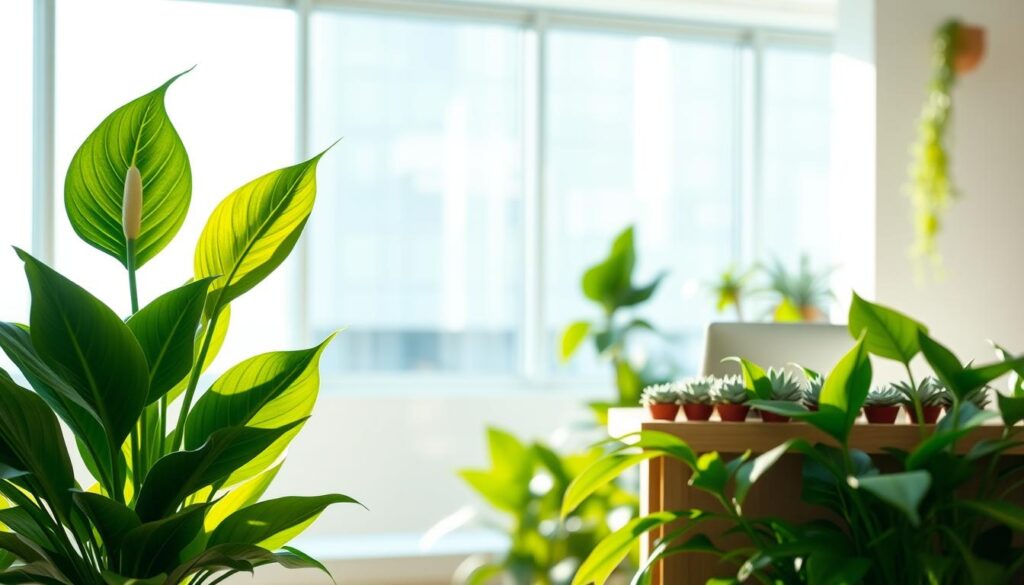
By embracing plants, businesses can create a workspace that supports the well-being of their employees, leading to a more productive and positive work environment.
Best Plants for Office Spaces: Top Recommendations
When it comes to selecting the best plants for office spaces, it’s essential to consider the lighting conditions and space constraints. Office environments vary greatly in terms of light availability and space, making it crucial to choose plants that are adaptable and low-maintenance.
Low-Light Tolerant Plants
For offices with limited natural light, plants like Snake Plants and ZZ Plants are ideal. These plants are known for their ability to thrive in low-light conditions and require minimal maintenance. Snake Plants, for instance, can survive with neglect and infrequent watering, making them perfect for busy office environments.
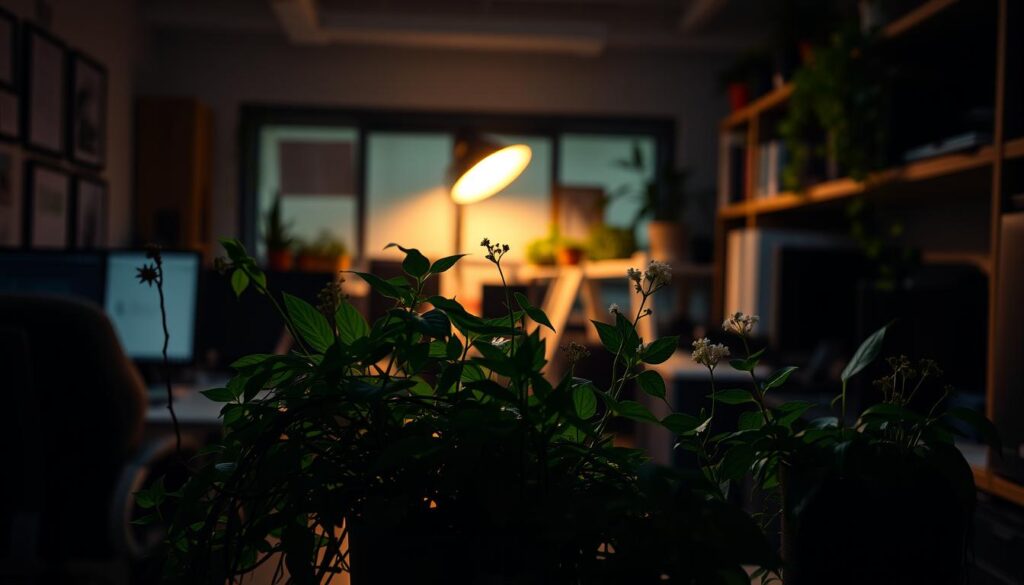
Medium to Bright Light Options
Offices with more generous lighting can support a wider variety of plants. Succulents and Cacti are excellent choices for brighter areas, as they not only tolerate direct sunlight but also add a unique aesthetic to the office decor. These plants are also relatively low-maintenance, requiring less frequent watering.
Desktop and Small Space Varieties
For smaller office spaces or desktop arrangements, compact plants like Pothos and Dracaena are highly recommended. These plants are versatile, easy to care for, and can thrive in a variety of lighting conditions. They also come in different shapes and sizes, allowing for creative office decor arrangements.
| Plant Type | Lighting Needs | Maintenance Level |
|---|---|---|
| Snake Plant | Low Light | Low |
| Succulents | Bright Light | Low |
| Pothos | Medium Light | Low |
Low Maintenance Office Plants for Busy Professionals
With increasingly demanding work schedules, opting for low-maintenance office plants is a practical way to enjoy the benefits of having plants around. Busy professionals can still have a lush office environment without dedicating too much time to plant care.
Nearly Indestructible Plant Options
Some plants are known for their hardiness and ability to survive with minimal care. Succulents and Cacti are prime examples, storing water in their leaves and stems, making them drought-tolerant. Succulents like Aloe Vera and Echeveria are not only low-maintenance but also offer health benefits. They require infrequent watering and can thrive in a variety of lighting conditions.

Plants That Thrive on Neglect
There are plants that not only survive but actually thrive when neglected from time to time. The ZZ Plant and Snake Plant are known for their ability to survive in low-light conditions and withstand neglect. These plants are perfect for offices with limited natural light and for those who often forget to water their plants.
| Plant Type | Lighting Needs | Watering Frequency |
|---|---|---|
| Succulents | Medium to Bright Light | Infrequent |
| ZZ Plant | Low Light | Rare |
| Snake Plant | Low to Medium Light | Occasional |
By choosing the right low-maintenance plants, busy professionals can enjoy the benefits of having office plants without the hassle of intensive care. As noted by gardening experts, “the right plant can make all the difference in a busy office environment.”
“Plants are not just decorative elements; they are living beings that purify the air and boost morale.”
Air Purifying Plants to Improve Office Air Quality
Air-purifying plants are not just aesthetically pleasing; they also play a crucial role in improving office air quality. By incorporating these plants into your workspace, you can create a healthier environment for employees, potentially boosting productivity and overall well-being.
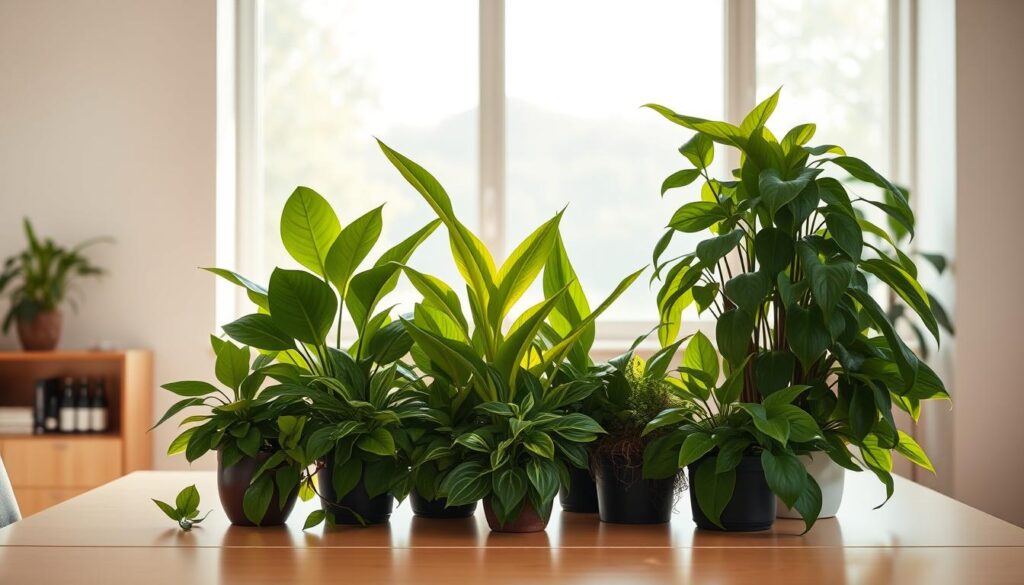
NASA-Approved Air Cleaners
NASA has identified certain plants that are highly effective at purifying the air. These NASA-approved air cleaners include plants like Peace Lilies and Spider Plants, known for their ability to remove toxins and pollutants from the air. Peace Lilies, for instance, are effective at removing ammonia and benzene, common office pollutants.
Other NASA-approved plants include Snake Plants and Dracaena. These plants are not only effective air purifiers but are also relatively low maintenance, making them perfect for busy office environments.
Plants That Combat Specific Office Pollutants
Different plants combat different pollutants. For example, Spider Plants are great at removing formaldehyde and xylene from the air, while Dracaena can remove trichloroethylene, a common pollutant found in offices due to printing and cleaning products.
By choosing the right plants, offices can significantly reduce the levels of harmful pollutants in the air, creating a healthier workspace. It’s about selecting plants that are not only beautiful but also beneficial for air quality.
Office Plant Care Essentials
The key to enjoying the benefits of office plants lies in proper care and maintenance. By understanding and implementing a few simple care strategies, you can keep your plants healthy and thriving.
Watering Schedules
Different plants have different watering needs. For example, succulents and cacti require less frequent watering compared to ferns and peace lilies. Establishing a watering schedule based on the specific needs of your plants is crucial.
- Check the soil moisture by inserting a finger into the soil up to the first knuckle.
- Water plants in the morning to give them the entire day to absorb the water.
- Avoid getting water on the leaves to prevent fungal diseases.
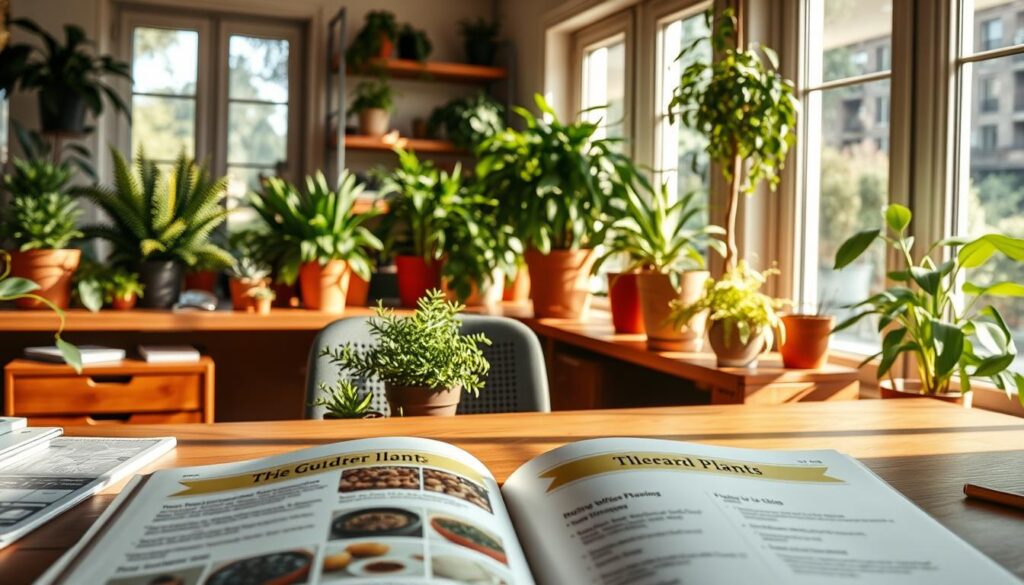
Light Requirements
Understanding the light requirements of your office plants is vital. While some plants thrive in low-light conditions, others need bright, indirect light.
Positioning plants according to their light needs can significantly impact their health and longevity.
Seasonal Adjustments
Office plants may require seasonal care adjustments. For instance, during the winter months, plants may need less water due to the dry air. Conversely, in the summer, they may require more frequent watering.
- Monitor temperature fluctuations and adjust plant positioning accordingly.
- Consider using a humidifier during dry seasons to maintain optimal humidity levels.
By following these office plant care tips, you can create a healthier, more productive work environment. Regular care and attention to your plants’ needs will ensure they continue to flourish.
Plants for Different Office Spaces
When it comes to office plants, one size doesn’t fit all, and different spaces require different types of greenery. The right plants can enhance the aesthetic and productivity of your office, whether it’s a cubicle, conference room, or window office.
Best Plants for Cubicles and Small Workstations
For small workstations and cubicles, compact and low-maintenance plants are ideal. Nerve Plants and Peperomia are excellent choices, thriving in low-light conditions and requiring minimal care. These plants add a touch of greenery to tight spaces without overwhelming the area.
Plants for Conference Rooms and Common Areas
Conference rooms and common areas benefit from larger, statement plants. Peace Lilies and Dracaena are popular choices, offering a sleek, professional look while purifying the air. These plants can make a significant impact in larger, more communal spaces.
Window Office Plant Options
Offices with windows can support a wider variety of plants, taking advantage of natural light. Consider plants like Succulents or Cacti, which thrive in bright conditions and add a unique touch to the office decor.
| Office Space | Recommended Plants | Light Requirements |
|---|---|---|
| Cubicles/Small Workstations | Nerve Plants, Peperomia | Low Light |
| Conference Rooms/Common Areas | Peace Lilies, Dracaena | Medium to Bright Light |
| Window Offices | Succulents, Cacti | Bright Light |
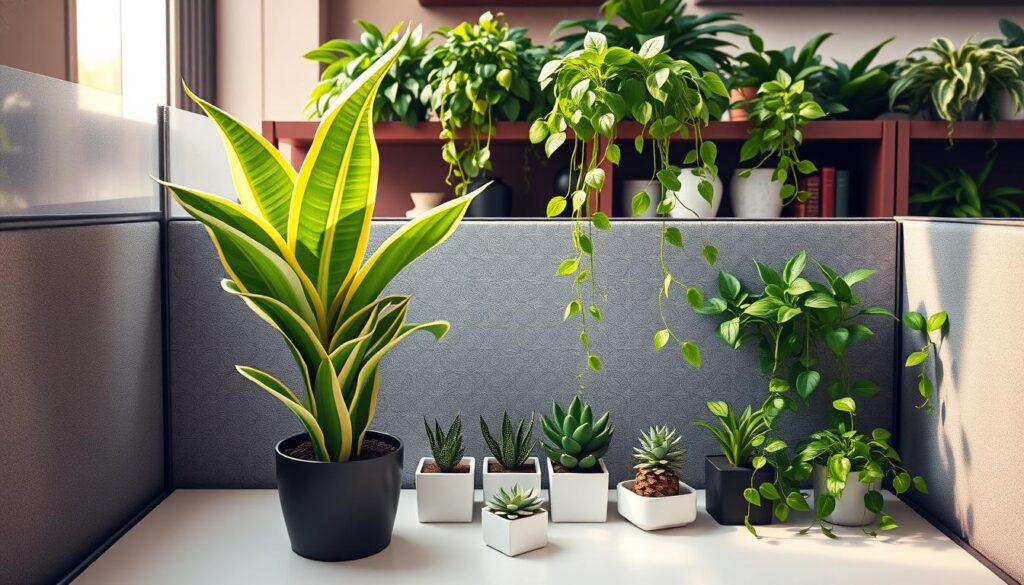
Conclusion: Creating Your Green Office Oasis
By incorporating office plants into your workplace, you can create a more welcoming and productive environment. The right plants can boost morale, improve air quality, and enhance overall well-being. Whether you have a small cubicle or a spacious office, there are plants for workplace productivity that can thrive in your space.
From low-maintenance succulents to air-purifying spider plants, the options are vast and varied. By choosing the right plants for your office, you can enjoy the many benefits they provide, including reduced stress and improved focus. So why not start your office plant journey today and create a healthier, more enjoyable workspace?
With the right care and attention, your office plants will flourish, bringing a touch of natural beauty to your workplace. By embracing the power of plants, you can create a green office oasis that benefits both you and your colleagues.

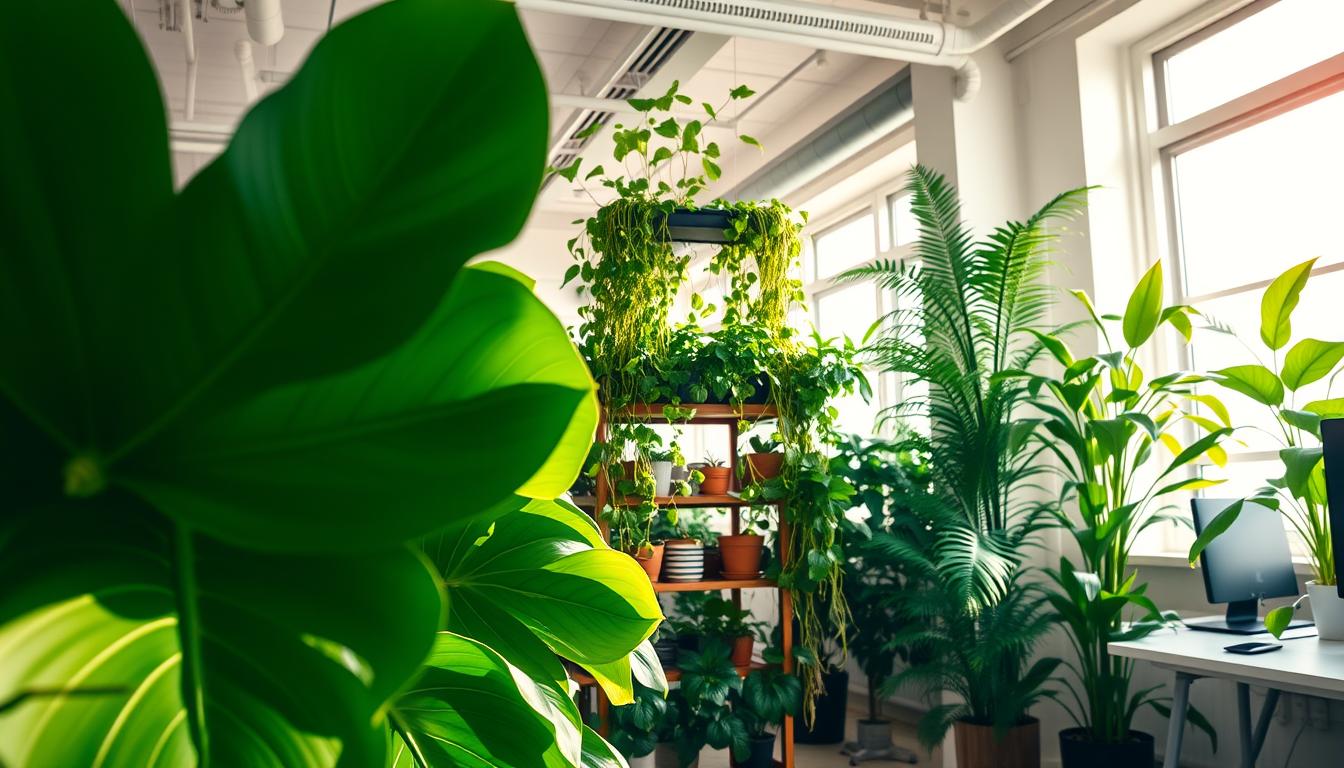
Leave a Reply